
About the Co-ParentPad, LGBTQI+ Parents, Long Read
About the Co-ParentPad: Developing the Co-ParentPad
Posted on 24th February 2023
We’ve been excited, this month, to launch our Co-ParentPad – a quick reference baby guide for LGBTQI+ non-birthing new parents and parents-to-be. Potentially the first of its kind in the UK, we decided that – although we set ourselves up to be a dad-focused organisation – there was a real need for a complementary product that our commissioning areas could use, alongside the existing DadPad resources, to help them support ALL the new families that they have contact with. You can read a little more about what it is and why we developed it here.
To that end, though, we knew that – just like DadPad – any alternative resource would need to be fully researched and written in a bespoke, tailor-made manner in order to meet the specific needs of the LGBTQI+ community. Our Project Officer, Georgie, has taken the lead in researching and developing this resource for us over the past 2-3 years, and we’ve therefore asked her to pull together a blog post which provides an overview of all the various stages that she went through to get the product from idea through to the tangible, hard copies that we now have ready to send out to our DadPad areas.
Initial research and development
The real work on the vision of what was to become the Co-ParentPad began in May 2020, when we were able to secure the budget to develop the concept of an equivalent resource to the DadPad, for same sex partners. The project was part-financed via funding received via a Follow-on Cash Grant from Smartline.
We began by scoping out what we hoped to achieve with a first resource for LGBTQI+ co-parents. We also undertook market research – to see what other written information was currently available for LGBTQI+ birthing and non-birthing people – and identified potential barriers to the development of such a resource, as well as solutions on how to overcome them.
Co-production: initial information gathering
Realising that co-production would be key to ensuring that our resource spoke with an authoritative and knowing voice, the team at Inspire Cornwall initially invited existing stakeholders – contacts we have made across the country via our existing work sharing DadPad with NHS Trusts, local authorities and other parent-focused organisations and experts – to express their interest in being involved with the development of our new resource.
I also shared this co-production invitation directly into virtual LGBTQI+ pregnancy, birth and parenting support groups, as well as personally contacting a number of LGBTQI+ organisations in the UK, to ask if they would like to either participate themselves and/or share the invitation amongst their own networks.
In hindsight, these first requests to participate and co-produce went out at a time when many families and professionals were struggling with the effects of the COVID-19 pandemic, meaning that their capacity and resources were limited. We therefore didn’t get the initial response to our invitations that we had hoped for, but were able to address this potential issue by dedicating additional time and resources to re-sharing the invitations in the virtual spaces for LGBTQI+ people.
In the end, we were able to work with a total of 16 participants, who collectively brought a real variety of personal and professional knowledge and experience to the table. We benefitted from feedback and suggestions from:
- parents;
- infant feeding and perinatal mental health peer supporters;
- birth educators, doulas and hypno-birthing practitioners;
- childcare providers;
- midwives and health visitor service providers;
- perinatal mental health and public health professionals; and
- perinatal service commissioners
Many of our contributors – and all of the lay participants/those with expertise via lived-experience – identify as LGBTQI+, and those who do not had either a professional interest in, or experience of working with, LGBTQI+ people, so we were confident that the information we have gathered from them is absolutely the best and most informed that we could get. And, although we weren’t able to secure the formal involvement of an LGBTQI+ organisation at this stage, many did respond with words of encouragement and signposting to resources which might aid us to develop the new resource.
The first of our co-production information-gathering events took place in June 2020, when I:
- facilitated two virtual focus groups via Zoom, in both the daytime and the evening;
- conducted several one-to-one interviews with key contributors; and
- exchanged email/online correspondence with a number of organisations and LGBTQI+ community groups.
Through these opportunities and conversations, we quickly learned that health service commissioners, public health professionals, and perinatal service providers wanted us to produce a new resource that respected the same values as all of Inspire Cornwall’s existing DadPad products, which also aim to tackle another gap in targeted perinatal information and resource-availabilty for a specific set of parents. For example, they wanted us to ensure that the new resource would:
- be just as carefully curated;
- contain the same recommendations and evidence-based information;
- share the same signposting to verified additional information and support; and
- be written in the correct and accessible language style for its intended readership.
From the feedback received from those with LGBTQI+ lived-experience we were able to learn that much of the existing information, recommendations and signposting available through the NHS and public health information was not appropriate for their needs or circumstances, as it was targeted towards heteronormative parenting dyads, and the research that had been relied upon as the evidence-base for the recommendations was not always applicable to LGBTQI+ parents.
This latter group of participants also shared that personalised care information needed to be made more relatable in order to be able to raise the awareness of LGBTQI+ parents-to-be regarding their options and rights to receive individualised care when accessing perinatal services. They also wanted there to be examples provided for health and social care professionals of what best practice care of LGBTQI+ parents-to-be should look like.
Specific challenges were also identified around:
- the collection, documentation and sharing of accurate patient data sets;
- the appropriate collection of and action on the medical history of both parents;
- sensitive conversations about – and an understanding of – the various methods of conception;
- both the birthing person and their partner being offered personalised care planning and actually receiving individualised care;
- navigating services which have historically only focused on birthing women and their male non-birthing partners;
- fully exploring all infant feeding options, and accessing appropriate signposting and support;
- the understanding and application of various evidence-based recommendations – such as in relation to safer-sleep guidelines – to LGBTQI+ parenting partnerships;
- targeted postnatal mental health information and support;
- contraception discussions and related post-birth recommendations; and
- the legal restrictions relating to applying for parental leave and registration of the birth of your baby/ies.
From these discussions, then, I was able to identify the following key subjects to research and focus on:
- information to aid the understanding of, and support to access, personalised pregnancy care;
- how to support a partner during labour, birth and the early days of parenthood;
- infant feeding choices;
- safer sleep recommendations;
- mental health awareness and support;
- postnatal contraception;
- use of trauma-informed and gender-affirming language; and
- the lack of representative perinatal imagery.
Researching the research
During the latter half of 2020, I began to undertake detailed reading and research relating to the specific themes and issues raised by the co-production participants, and began to explore how best to present the information that an LGBTQI+ non-gestational parent-to-be might need to know, whilst also preparing for parenthood and trying to access appropriate care for their partner and themselves.
Over the last 5-10 years, accessibility to health and social care services for LGBTQI+ people has been more publicly discussed and researched, highlighting many disparities for LGBTQI+ people in the world today. One of the many areas of disparity is in relation to experiences of gynaecological, reproductive, fertility, conception, and perinatal care and services.
The recent focus on addressing LGBTQI+ inequalities in health and social care access in the UK has been thanks to the consistent international campaigning of LGBTQI+ organisations and high-profile LGBTQI+ individuals and allies, as well as members of the LGBTQI+ community sharing and discussing their experiences more openly via social media, films and documentaries.
The UK LGBTQI+ research, evidence and information landscape has therefore been changing rapidly throughout the time that the Co-ParentPad has been in development. I therefore not only had to explore as much of the existing shared experiences, information, and research in the international public domain as possible, but also keep up with the ongoing discussions, news and emerging information and research, too.
As well as existing and previously published DadPad blog posts on LGBTQI+-related parenting research – here and here – I’ve also put together an up-to-date piece, gathering together all the key research and development that I needed to keep an eye on during the Co-ParentPad development process, which you can find here.
As part of this ongoing research and reading, I also needed to take the time to refamiliarise myself with – and consider in the context of LGBTQI+ parenting dyads and families – much of the key evidence-based guidance, policies, codes of practice, legislation and standards which relate to early parenthood. This included in particular the existing safer co-sleeping guidelines, and the WHO International Codes on the Marketing of Breast-milk Substitutes and the UNICEF Baby-Friendly Initiative (BFI) Standards. The latter in particular set specific restrictions on the information and imagery that can be shared regarding infant feeding, but all have been written in the context of supporting, protecting and benefitting the traditional ‘Mother-and-Baby’ dyad, which is not necessarily transferrable or applicable to the needs of LGBTQI+ service users, who may need or wish to consider alternative feeding options, and who are also more likely to need specialist support than heteronormative parents.
My ‘solution’ to this was to attempt to seek guidance and clarification from a number of expert and experienced voices – including: directly with the BFI; within online groups for infant feeding specialists and supporters, and for BFI professionals and supporters; and infant feeding networks for health and social care professionals. The difficulty which became clear from these interactions is that information and guidance is still significantly lacking in relation to LGBTQI+ people and their needs, and that international and national policies, procedures and legislation are not ‘one size fits all’. As a result, drafting the infant feeding content for the Co-ParentPad was perhaps one of the most challenging and time-consuming elements of the overall project – but we hope that what we have produced is sufficient to meet all needs as well as keeping within the guidance.
This also included having to challenge the use of evidence-based recommendations to LGBTQI+ parenting dyads in relation to safer co-sleeping guidelines, and challenging the application of the
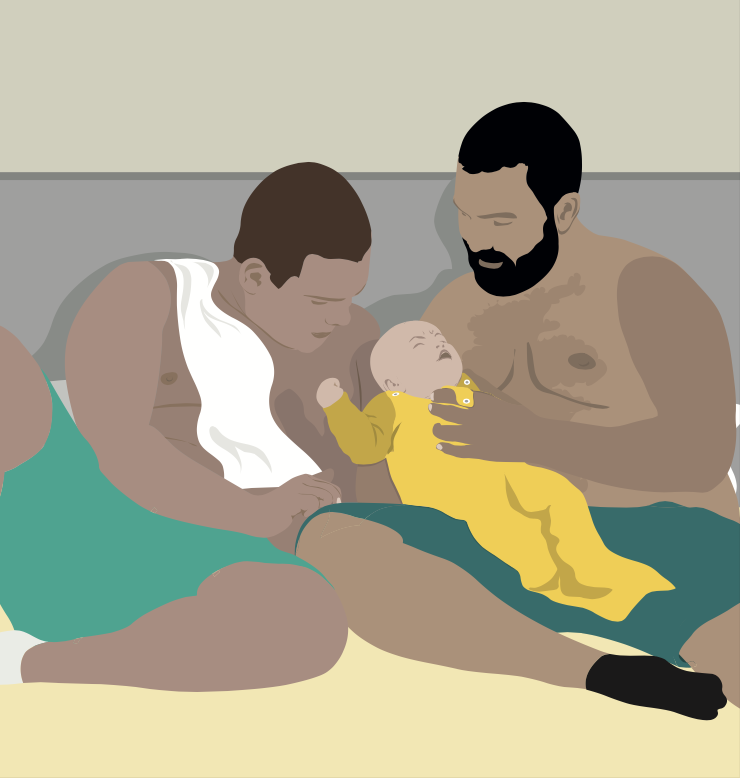
Additional learning
I have long been interested in LGBTQI+ issues, especially in relation to accessing healthcare and perinatal care, due to shared first-hand experiences within close family and friendships. Whilst I am a cisgender woman, in a heterosexual relationship, I have grown up with LGBTQI+ family and friends and, during my last five-and-a-half-years as a birth and postnatal doula, also worked with LGBTQI+ clients.
I had therefore been learning about and joining in conversations relating to LGBTQI+ experiences of fertility, pregnancy, birth and parenthood prior to being asked to start working on the Co-ParentPad for Inspire Cornwall.
‘Every day is a school day’, though, and the team and I wanted to make sure that I stayed up-to-date with emerging information, research and developments in relation to LGBTGI+ families and perinatal care, so Inspire Cornwall invested in additional training and resources to support my work in the development of specific information and content for the Co-ParentPad, including:
- gender-affirming language use;
- infant feeding choices;
- safer sleeping guidelines;
- LGBTQI+ mental health; and
- LGBTQI+ contraception options.
In terms of training, in December 2021 and March 2022 I joined two valuable paid workshops with The Queer Birth Club – LGBTQ+ Competency in Birth and Beyond and LGBTQ+ Lactation Competency – created and facilitated by an LGBTQI+ lived-experience expert, parent, birth worker and lactation consultant, AJ Silver. They also recently published a book – Supporting Queer Birth: a book for birth professionals and parents – which brings together their personal and professional experiences, and the voices of many other LGBTQI+ parents, to “explain what healthcare and birth workers can do to improve care for their [LGBTQI+] clients“.
AJ’s workshops and written materials really helped me to challenge and deepen my knowledge, skills and language in relation to supporting LGBTQI+ parents through the perinatal period. Their workshops also provided a safe space to ask ‘those’ questions and to have open conversations about the things that I was worried about saying and which could have unintentionally upset or hurt an LGBTQI+ person if raised in the public domain.
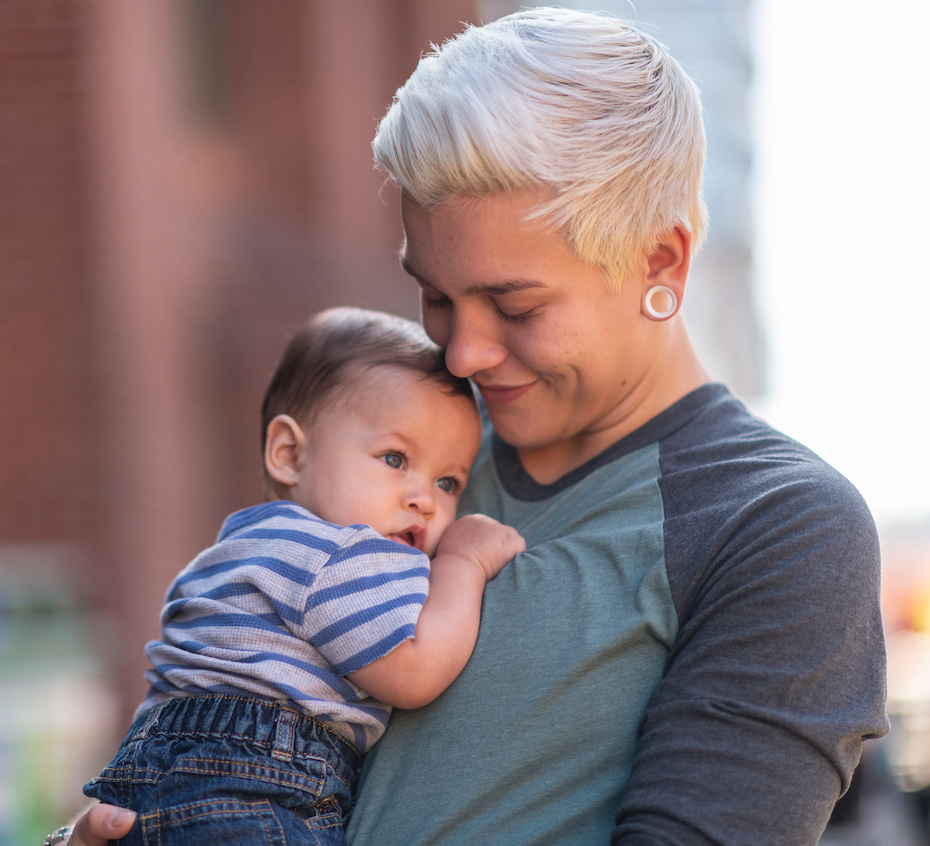
Drafting the Co-ParentPad
Following this initial period of information-gathering and research, at the start of 2021 I produced a preliminary draft of the resource, containing all of the topics that we had identified during the co-production meetings and discussions. The team at Inspire Cornwall carefully reviewed this draft in order to identify which content would remain in the Co-ParentPad, and which would inform the development of new LGBTQI+-focused blogs.
At the same time, we began to explore how best to combine both gender-affirming alternative language and easy-read language, to meet our aim of ensuring that the resource would be as accessible as possible for all service users. Taking into account the challenges raised in trying to combine these two writing styles, the Inspire Cornwall team made the decision to categorise the first edition of the Co-ParentPad as a ‘hybrid’ resource – something between our full ‘essential guide’ DadPad and our Quick Read version.
In October 2021, I produced the first full written draft of the Co-ParentPad, together with the basic illustrations that had so far been developed, in a hand-drawn layout. Collectively, the team at Inspire Cornwall reviewed and edited this draft – in liaison with our ‘Easy Read’ consultant – in order to identify gaps and potential formatting issues.
The team then developed a working document, which catalogued the text, our ever-growing list of illustrations, and an overview of the layout and formatting decisions for us, our illustrator, designer and – eventually – printers to work on.
It was also around this time that we finally settled upon the title for the resource. For so long in the planning we’d experimented with different ideas – with the ‘PartnerPad’ being a popular one – but it was after receiving some really helpful feedback from fellow ‘dadvocate’ and parent support worker, Kieran Anders of Dad Matters UK, that we eventually decided upon the ‘Co-ParentPad’. This allowed us time to ‘test out’ the title with various people that we spoke to in relation to the development of the resource and – whilst no name will ever be perfect – we felt confident that this was the right one to use.
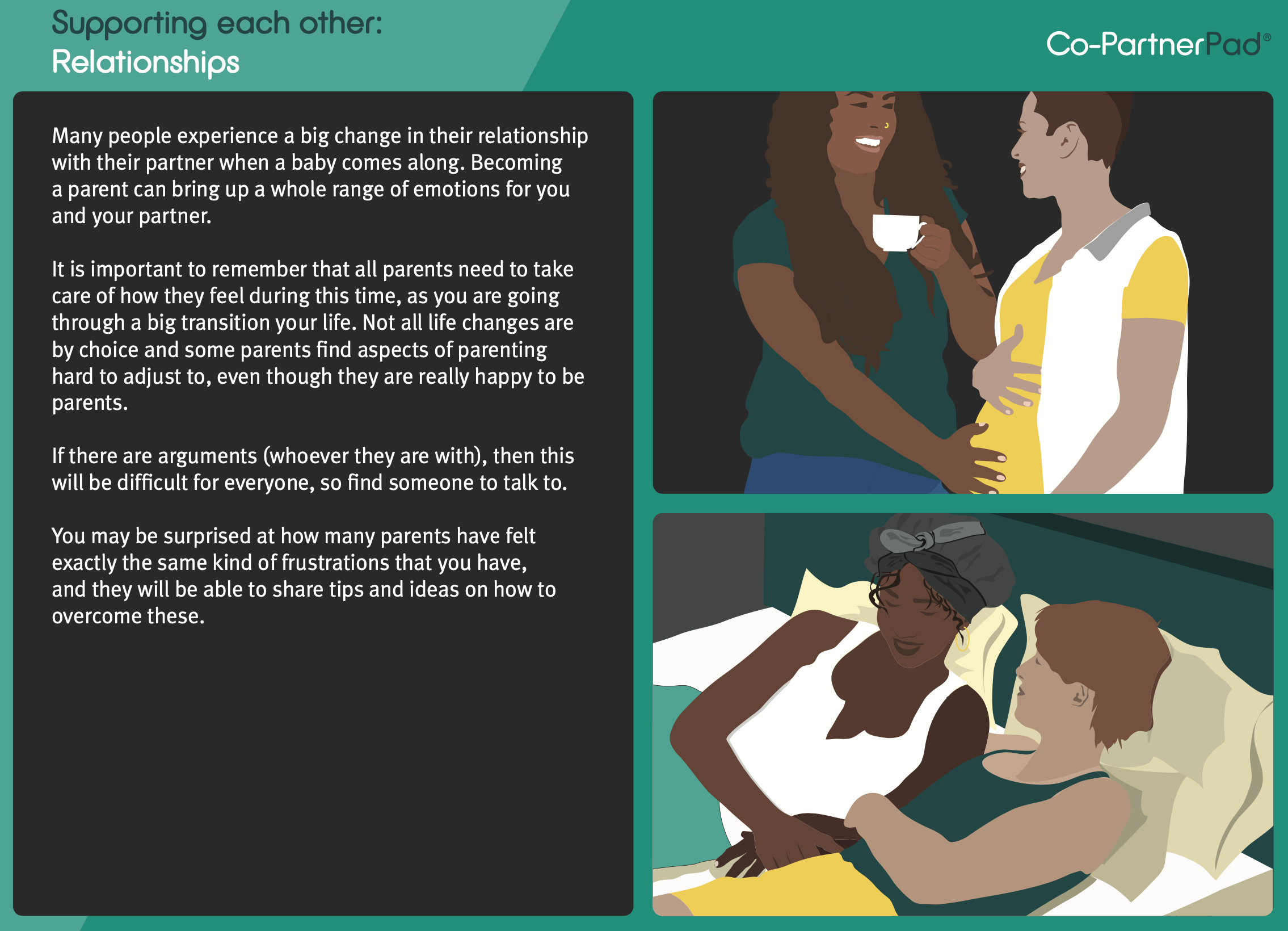
Designing the images
It was decided fairly early on in the development process, that – given the lack of representation and variety available in stock photography images, alongside our desire to support the reader’s accessibility of the information – we would work with an illustrator to create our own bespoke imagery to use within the resource.
Finding the right imagery to match the written content is a really important part of the resource-creation process, as we need to make sure we’re accurately modelling the actions and behaviours we’ve written about. Having imagery alongside written content helps to improve the accessibility of a resource, especially when we’re describing a step-by-step process.
We also have to make sure that we stick to important codes of practice and guidelines related to perinatal care, so there is a lot to think about when we’re looking for new imagery to include in any of our resources, or on our website and social media posts.
Working with our freelance illustration team was a long and intensive – but rewarding – process. It was really important to me that we showed a range of parents – in terms of their relationship dyad, sexuality, gender, ethnicity and body size – within the Co-ParentPad resource. Each time a new image was undergoing development, I needed to consider not only the accuracy and context of the illustration itself, but also how it fitted into the overall illustration collection as a whole.
As we had already successfully developed a catalogue of illustrations for the Quick Read DadPad, we started by checking what we already had that was suitable to use, identify images which we thought could be adapted for the altered format, and compile a list of images that would need to be created from scratch.
During the winter, I worked with our illustrator to develop and/or adapt the required individual images. The process for developing each illustration would often start out as a ‘mood board’ of images from which we could pick out the parts that we did and didn’t like. During the early stages of the design process, my main focus was on accurate modelling of actions and behaviours, and the correct context.
The next step was to create a list of desirable characteristics for personalising the ‘characters’ which the illustrator then used in order to mock up a basic illustration, so that we could see if everything worked together when it was combined. If it did, then great – the illustrator could simply get on with creating the complete illustration. But if it didn’t work, then it was a case of swopping in and out some of the personalisation elements until we were all satisfied with how the image looked. In some cases, though, we ended up having to – literally – go back to the drawing board and start again.
And the illustration development didn’t stop there…
From March to September, we worked collectively with our designer, using various hand-drawn layout guides, illustration lists and formatting instructions, to create a digital draft of the resource. Despite our best efforts during the earlier stages of development, we still needed to do much tweaking of both the overall layout and the formatting of the resource, as well as to the images used, to ensure:
- the illustrations were accurately conveying the exact actions and behaviours described;
- maximisation of the resource’s readability; and
- that we were meeting all relevant imagery guidelines (including those covered by the UNICEF Baby-Friendly Initiative Standards and WHO International Code on the Marketing of Breast-milk Substitutes)
Once this was done, we worked through each page of the resource as a whole team, checking for formatting issues and scrutinising the illustrations as a whole.
In this final stage of image development, the majority of illustration tweaks were relatively minor, such as making colour palette adjustments to images that formed part of a set of instructions, so that they ‘flowed’ well when viewed as a series. However, there were one or two illustrations that threw up some unexpected challenges and which needed further research before going back to the illustrator for a final attempt to get them ‘just right’.
There were inevitably some illustrations that we had to make the difficult decision to omit from the resource for now, but I’m happy with what we have been able to achieve with the images overall. Our aim is that – if you are an LGBTQI+ parent – you will be able to spot at least one image within the Co-ParentPad that you can identify with; and, if you can’t, please do let us know, as we’re always keen to keep developing and building on our visual resources!
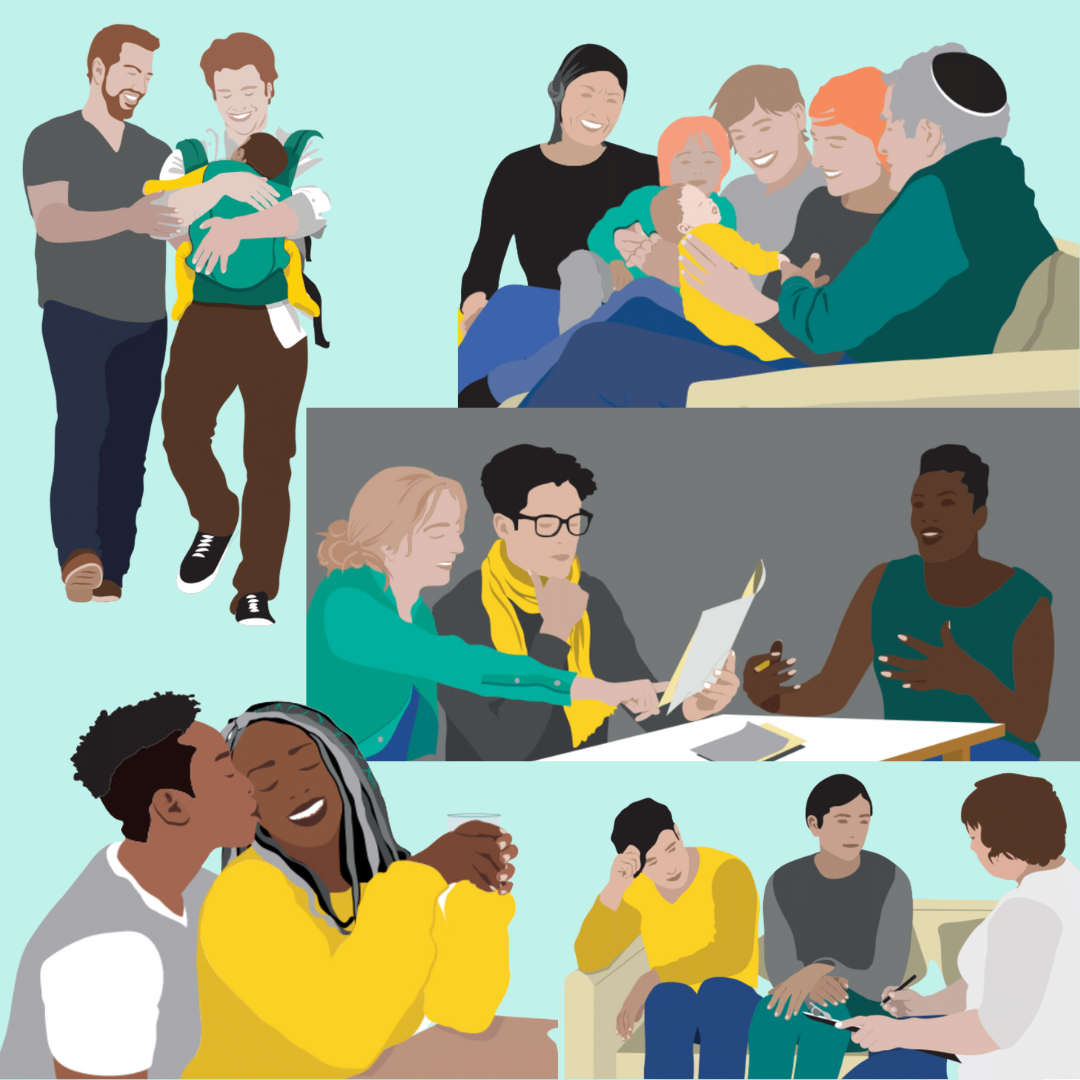
Final reviews and sign-off
As everyone returned to work after the summer break, we went back to our existing stakeholder and co-production participants to invite them to undertake a final review of the resource. As a number of individuals had moved on to other work, or no longer had the time to participate due to other commitments, we used the additional contacts that we had made throughout the development of the resource, alongside my continuing access to online LGBTQI+ pregnancy, birth and parenting groups – to find new, independent participants to review the resource in its final stages.
Following the responses that we gained, the Inspire Cornwall team made the final edits to the Co-ParentPad, forwarding these to our designer for incorporation into our working document.
In December, after a thorough, final review of the print-ready design and after so many months in development, as a team we signed off on the product, before it was sent on to our printers here in Cornwall.
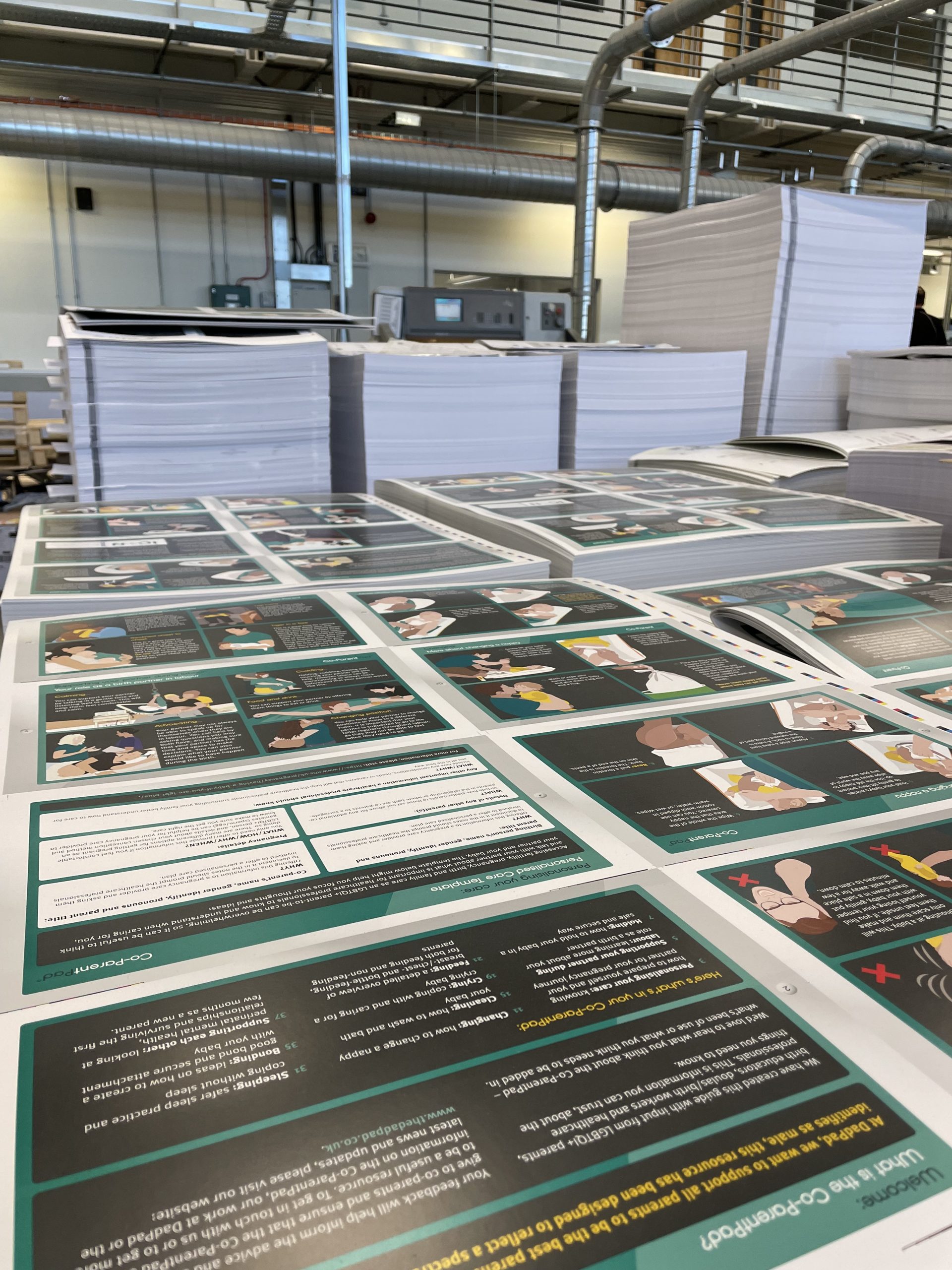
Releasing the Co-ParentPad
We were delighted to receive the first copies of the Co-ParentPad from our printers in early January, which gave us time to evaluate and check that we were happy with the final quality of the product. We sent initial copies out to some of our key contributors and to some who had responded to initial social media posts, and started gathering any feedback to be considered for future print-runs and development of the resource – the review process for version 2 has already begun!
We’ll end with some words from Julian, DadPad CEO:
We are so pleased that we can now start distributing resources across the UK to help support partners of all birthing people. We’re endeavouring to send out the first sets of Co-ParentPads – at no extra cost – to all of our DadPad commissioning areas in the UK during the first half of 2023, to act as a complement to our existing DadPad offer. As we approach a full launch of the Co-ParentPad in Brighton & Hove this coming summer, we look forward to being able to gather together to celebrate this amazing achievement and showcasing the use of the resource.
To find out more about the Co-ParentPad, including how to obtain copies, please contact the team at Inspire Cornwall.

